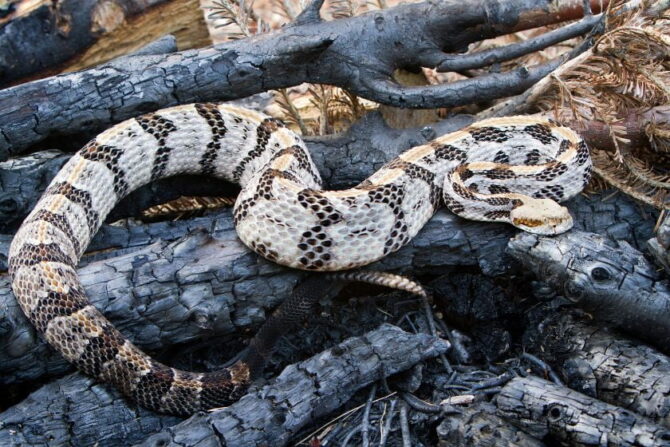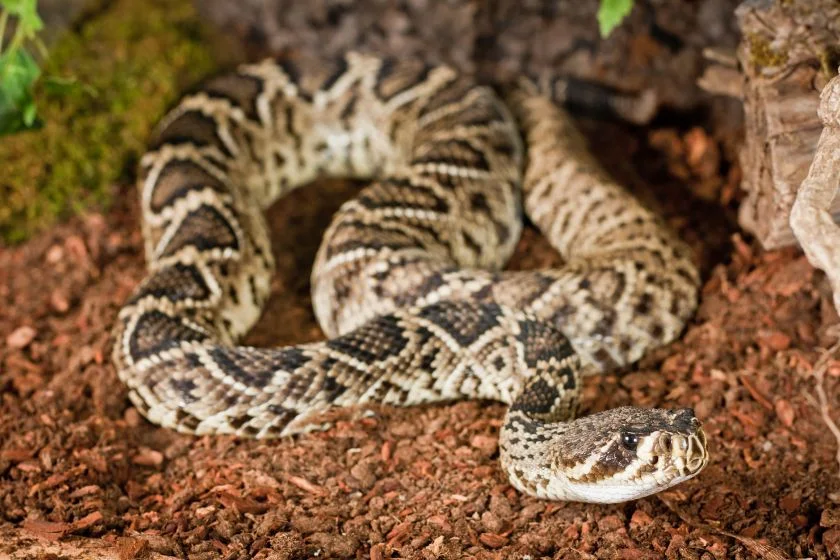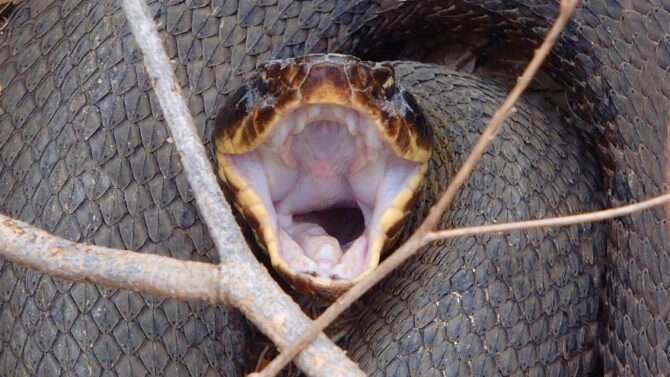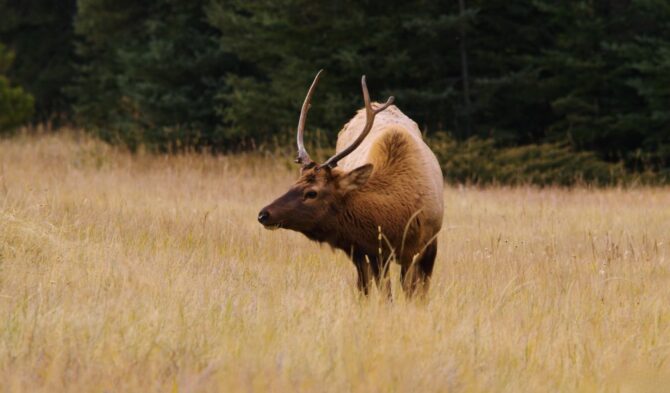Georgia is home to many snakes, around 46 of them, but the good news is that most of them aren’t poisonous.
There are only six poisonous snakes in the state, all of which have their identifying markers.
Venomous snakes in Georgia are cottonmouth, eastern diamond rattlesnake, timber rattlesnake, pygmy rattlesnake, coral snake, and eastern copperhead.
Distinguishing them from non-venomous species can help keep you safe.
We’ll look into each of these deadly snakes in detail, including all the information you should know.
The Venomous Snakes in Georgia
1. Cottonmouth (Agkistrodon piscivorus)

- Size: 26 to 35 inches
- Habitat: Creeks, streams, marshes
- Identifying Features: Broad neck, black color with patterns
- Behavior: Flattening the body, snapping jaws, opening mouth
- Threats: Cytotoxin, hemotoxin
The cottonmouth is widespread in West Atlanta, Georgia, as well as the southern parts of the United States.
It goes by a host of other names like the black moccasin, the gaper, the mangrove rattle, and others.
The main name is gotten from its behavior. It gapes its mouth at an intruder, exposing the white within.
This snake has a strong venom that hurts at best and can kill if not treated. Its venom contains cytotoxins that destroy tissues and hemotoxins that stop clotting.
The latter inevitably leads to bleeding. The good part is cottonmouths don’t always bite unless they feel threatened.
2. Eastern Copperhead (Agkistrodon contortrix)

- Size: 20 to 37 inches
- Habitat: Deciduous forests, mixed woodlands
- Identifying Features: Broad head, pale tan color, patterns
- Behavior: Nocturnal, lying still
- Threats: Painful bites
The eastern copperhead is simply known as the copperhead. It can be found only in the eastern side of North America.
Eastern copperheads inhabit deciduous forests and mixed woodlands, though they live in other habitats like rock outcroppings and ledges.
This snake has a beautiful color and pattern, but it should come with a “Caution: Do not Approach!” sign.
Though they are not always aggressive, they can bite and pass venom to you.
The copperhead often gives a warning bite with very low venom, and only if you persist does it bite for real.
Venom isn’t always fatal, but it causes symptoms like swelling, nausea, and extreme pain.
3. Eastern Coral Snake (Micrurus fulvius)

- Size: 31 inches
- Habitat: Flatwoods, tropical hammocks
- Identifying Features: Colorful red and black pattern, long tails
- Behavior: Elusive, almost aquatic
- Threats: Neurotoxin
The eastern coral snake is one of 16 coral snake species, all included in the Elapidae family.
They live in the United States, both in Georgia and others. The eastern coral snake is endemic to the eastern side.
Alternative names are the American cobra and common coral snake.
The eastern coral snake closely resembles the scarlet snake and the scarlet kingsnake.
However, it is not harmless like its counterparts. This reptile’s venom contains a neurotoxin that causes adverse effects in both prey and humans.
For humans, symptoms include double vision, slurred speech, paralysis, and breathing failure.
4. Pygmy Rattlesnake (Sistrurus miliarius)

- Size: 16 to 24 inches
- Habitat: Flatwoods, mixed forests, sandhills
- Identifying Features: Small, dorsal pattern
- Behavior: Aggressive or lethargic
- Threats: Cytotoxin, hemorrhagic
The pygmy rattlesnake is found only in the southeastern parts of the United States, including Georgia.
It is more widespread in the latter, being found in the central, northeastern, and northwestern areas.
It is the smallest venomous snake in the United States, which explains the name “pygmy.”
This snake should not be underestimated, however. Its venom contains cytotoxin, which easily kills prey but isn’t enough to be fatal to a human.
That being said, getting bit is still a serious problem that may need medical attention.
5. Timber Rattlesnake (Crotalus horridus)

- Size: 36 to 60 inches
- Habitat: Deciduous forests
- Identifying Features: Gray color, stripes on the back, pinkish hue
- Behavior: Docile, solitary
- Threats: Hemotoxin, neurotoxin
The timber rattlesnake is also known as the canebrake rattlesnake and the banded rattlesnake.
It is found only in eastern North America, staying in most parts of Georgia.
It generally inhabits deciduous forests, though pregnant females may stay on open, rocky ledges.
The timber rattlesnake is dangerous and highly venomous, potent enough to kill a human.
The venom contains both hemotoxins and neurotoxins, both of which can cause paralysis and hemorrhaging. A victim can survive if put on immediate treatment.
6. Eastern Diamondback Rattlesnake (Crotalus adamanteus)

- Size: 7.8 ft
- Habitat: Pine forests, sandhills, coastal maritime hammocks
- Identifying Features: Large head, bulky, blackish brown, olive or dusty gray color, patterns
- Behavior: Solitary, cold-blooded
- Threats: Crotalase
The eastern diamondback rattlesnake is the largest venomous snake in the Americas, which alludes to its danger.
It is native to the Southeastern United States, where it is endemic. It inhabits pine forests, sandhills, and coastal maritime hammocks.
This snake’s color makes it able to camouflage in the wild. This increases the chances of getting accidentally bit by one.
The venom contains an enzyme known as crotalase which clots the fibrinase.
Symptoms include internal pain, a weak pulse, swellings, and overall intense pain.
Final Thoughts
Fortunately, there are fewer venomous snakes than non-venomous snakes in Georgia.
You have fewer chances of getting bit, especially if you can detect the poisonous ones.
As a general rule, be cautious around any snake you find in the state, whether venomous or otherwise.
If you or anyone close get bit by a deadly snake, seek medical attention immediately.
Up Next…
.






